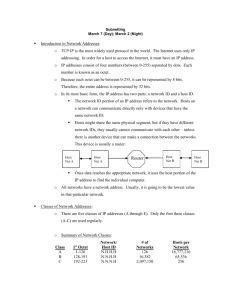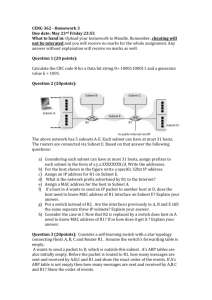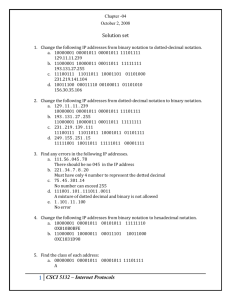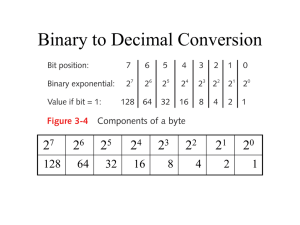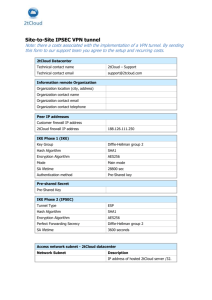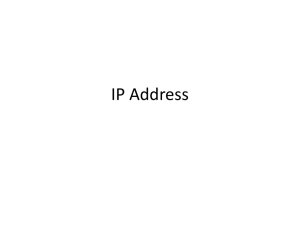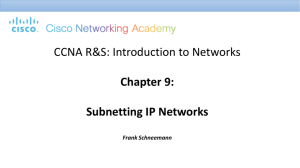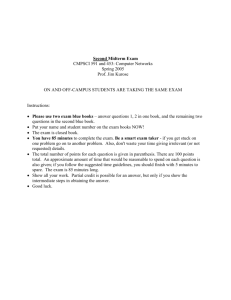Lecture Notes
advertisement
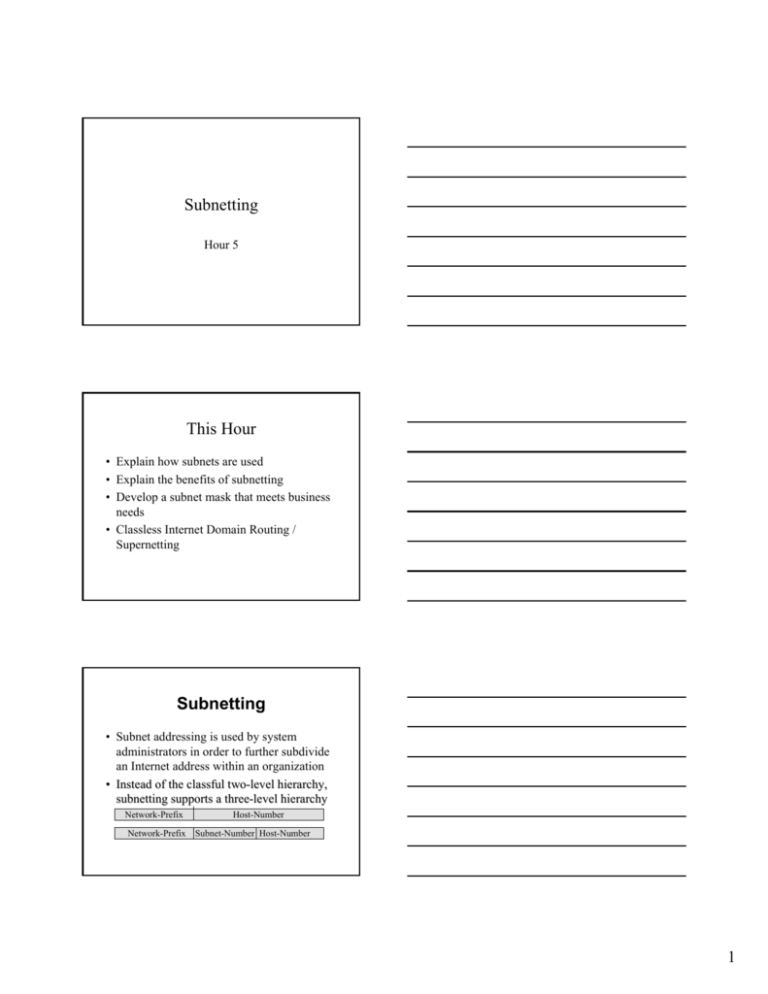
Subnetting Hour 5 This Hour • Explain how subnets are used • Explain the benefits of subnetting • Develop a subnet mask that meets business needs • Classless Internet Domain Routing / Supernetting Subnetting • Subnet addressing is used by system administrators in order to further subdivide an Internet address within an organization • Instead of the classful twotwo-level hierarchy, subnetting supports a threethree-level hierarchy Network-Prefix Network-Prefix Host-Number Subnet-Number Host-Number 1 Subnetting • Subnetting attacked the expanding routing problem by ensuring that the subnet structure of a network is never visible outside of the organization’s private network • The route from the Internet to any subnet of a given IP address is the same, no matter which subnet the destination host is on • All subnets of a given network number use the same network-prefix but different subnet numbers Subnetting Extended-Network-Prefix • Routers within the subnetted environment use the extended-network-prefix to route traffic between the individual subnets • The extended-network-prefix is composed of the classful network-prefix and the subnet-number • The extended-network-prefix has traditionally been identified by the subnet mask Example (fig 5.5) 2 Example (Fig 5.7) Subnet Mask • The subnet mask is a 32 bit number expressed in decimal format and applied at each interface of a routing device where subnetting is actually required. • To determine the subnet mask value, a decision is first made as to the number of subnets which are required. Setting the value of the Mask • The subnet mask is set by creating a 32 bit binary number using these rules. Place: – 1’s for the netid portion – 1’s for the subnet portion – 0’s for the host portion • Convert the resulting binary string into decimal format and apply to each which is using subnetting. 3 Calculating the Total subnets • When calculating how many subnets can be created from a number of bits, the bit wieght is NOT USED: – to calulate the total number of addressable subnets, raise two to the number of bits allocated to the subnet mask Variation in the total number of available Subnets • The final number of available addressable subnets can vary depending on routing equipment and software: – older equipment will not allow the use of all zeros or all ones to number subnet ID’s. This means the loss of two subnet numbers – modern equipment supports the use subnet numbers of all zeros and all ones Calculating the Decimal value of the Subnet Mask • When converting the subnet mask from binary to decimal, bit weight must be considered in each of the octets where the mask has been applied: – a mask of 11100000 becomes 128+64+32 = 194 4 Host Numbers • Two addresses are always invalid in the hostid: – all zeros: which is allocated to the subnet, also called the segment or cable address. This identifier is used in route tables as Destination.. – all ones: which is allocated to the broadcast address. Every subnet has it’s own unique broadcast address. Subnet masks Example #1: Class C • If sixteen subnets are required in a Class C site, then four subnet bits will be required: 2 X 2 X 2 X 2 = 16 • This leaves four bits remaining in the hostid portion, so 14 hosts can exist on each subnet (because two host addresses are lost for the cable and broadcast addresses). Subnet Masks Example #1: Class C • By using four bits, the subnet mask in binary will be: 11111111.11111111.1111111.11110000 • Which in decimal equates to 255.255.255.240 5 Subnet Masks Example #2: Class B • If 256 subnets were required for a Class B address, eight bits (one octet) would be needed for the mask: 2 X 2 X 2 X 2 X 2 X 2 X 2 X2 = 256 Subnet Masks Example #2: Class B • By using eight bits, the subnet mask in binary will be: 11111111.11111111.1111111. 00000000 • Which in decimal equates to 255.255.255.000 How is the Subnet Mask used to forward datagrams? • When a routing interface has non-default subnet mask applied, it performs a LOGICAL AND using: – the destination address in the IP datagram – and the subnet mask • The result of this operation will yield the destination subnet, which can be identified in the route table 6 LOGICAL AND • In a LOGICAL AND, which is a binary operation, only the addition of binary values of 1 AND 1 will result in 1. • This means that the host portion will be cancelled out, since zeros are used in the host portion of the subnet mask. LOGICAL AND operation Example #3: Class B, 8 bit mask • Destination IP Address: 136.186.105.28 • Subnet Mask: 255.255.255.0 10001000.10111010.01101001.00011000 AND 11111111.11111111.11111111.00000000 RESULT 10001000.10111010.01101001.00000000 136.186.105.0 LOGICAL AND operation Example #4: Class C, 5 bit mask • Destination IP Address: 201.222.5.121 • Subnet Mask: 255.255.255.248 11001001.11011110.00000101.01111001 AND 11111111.11111111.11111111.11111000 RESULT 11001001.11011110.00000101.01111000 201.222.5.120 7 Confused? • In the previous slide, the resulting subnet destination address doesn’t end up with a zero in the hostid portion, as might be expected. This is because the mask operates within an octet, at a bit level. Subnet addresses in these situations will look like host addresses, demonstrating the need to consider the impact of masking. Default Subnet Mask • If subnetting is not used, then a default mask is used at the routing interface to complete the route selection process. • The default mask uses all 1’s for the netid, which, during the AND operation, will remove the hostid portion of the destination address within the datagram, leaving the netid for proper route determination. Default Subnet Masks for IP Address Classes • Class A = 255.0.0.0 • Class B = 255.255.0.0 • Class C = 255.255.255.0 8 Bibliography • “Teach Yourself TCP/IP in 24 Hours, Second Edition”, Joe Casad, Sams Publishing, March 01, 2001 • Addressing (PPT), Tamanna Sait & Aneesha Deo • Subnetting, http://cit.wta.swin.edu.au/cit/subjects/CITP 0040/docs/subnets.ppt 9


